Tuochao Chen
Wireless Hearables With Programmable Speech AI Accelerators
Mar 24, 2025Abstract:The conventional wisdom has been that designing ultra-compact, battery-constrained wireless hearables with on-device speech AI models is challenging due to the high computational demands of streaming deep learning models. Speech AI models require continuous, real-time audio processing, imposing strict computational and I/O constraints. We present NeuralAids, a fully on-device speech AI system for wireless hearables, enabling real-time speech enhancement and denoising on compact, battery-constrained devices. Our system bridges the gap between state-of-the-art deep learning for speech enhancement and low-power AI hardware by making three key technical contributions: 1) a wireless hearable platform integrating a speech AI accelerator for efficient on-device streaming inference, 2) an optimized dual-path neural network designed for low-latency, high-quality speech enhancement, and 3) a hardware-software co-design that uses mixed-precision quantization and quantization-aware training to achieve real-time performance under strict power constraints. Our system processes 6 ms audio chunks in real-time, achieving an inference time of 5.54 ms while consuming 71.6 mW. In real-world evaluations, including a user study with 28 participants, our system outperforms prior on-device models in speech quality and noise suppression, paving the way for next-generation intelligent wireless hearables that can enhance hearing entirely on-device.
Target conversation extraction: Source separation using turn-taking dynamics
Jul 15, 2024Abstract:Extracting the speech of participants in a conversation amidst interfering speakers and noise presents a challenging problem. In this paper, we introduce the novel task of target conversation extraction, where the goal is to extract the audio of a target conversation based on the speaker embedding of one of its participants. To accomplish this, we propose leveraging temporal patterns inherent in human conversations, particularly turn-taking dynamics, which uniquely characterize speakers engaged in conversation and distinguish them from interfering speakers and noise. Using neural networks, we show the feasibility of our approach on English and Mandarin conversation datasets. In the presence of interfering speakers, our results show an 8.19 dB improvement in signal-to-noise ratio for 2-speaker conversations and a 7.92 dB improvement for 2-4-speaker conversations. Code, dataset available at https://github.com/chentuochao/Target-Conversation-Extraction.
Look Once to Hear: Target Speech Hearing with Noisy Examples
May 10, 2024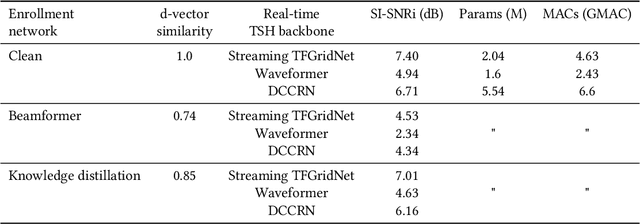
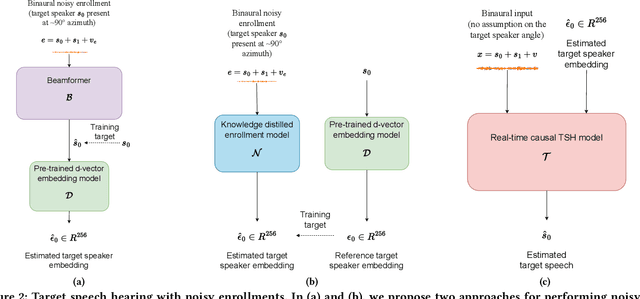

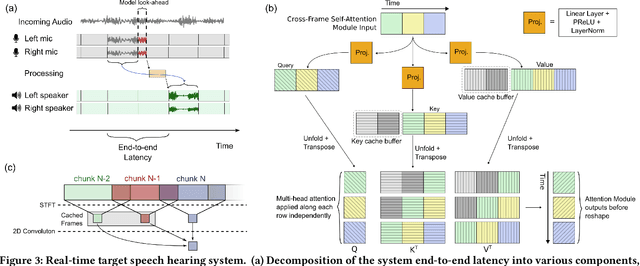
Abstract:In crowded settings, the human brain can focus on speech from a target speaker, given prior knowledge of how they sound. We introduce a novel intelligent hearable system that achieves this capability, enabling target speech hearing to ignore all interfering speech and noise, but the target speaker. A naive approach is to require a clean speech example to enroll the target speaker. This is however not well aligned with the hearable application domain since obtaining a clean example is challenging in real world scenarios, creating a unique user interface problem. We present the first enrollment interface where the wearer looks at the target speaker for a few seconds to capture a single, short, highly noisy, binaural example of the target speaker. This noisy example is used for enrollment and subsequent speech extraction in the presence of interfering speakers and noise. Our system achieves a signal quality improvement of 7.01 dB using less than 5 seconds of noisy enrollment audio and can process 8 ms of audio chunks in 6.24 ms on an embedded CPU. Our user studies demonstrate generalization to real-world static and mobile speakers in previously unseen indoor and outdoor multipath environments. Finally, our enrollment interface for noisy examples does not cause performance degradation compared to clean examples, while being convenient and user-friendly. Taking a step back, this paper takes an important step towards enhancing the human auditory perception with artificial intelligence. We provide code and data at: https://github.com/vb000/LookOnceToHear.
Underwater 3D positioning on smart devices
Jul 20, 2023



Abstract:The emergence of water-proof mobile and wearable devices (e.g., Garmin Descent and Apple Watch Ultra) designed for underwater activities like professional scuba diving, opens up opportunities for underwater networking and localization capabilities on these devices. Here, we present the first underwater acoustic positioning system for smart devices. Unlike conventional systems that use floating buoys as anchors at known locations, we design a system where a dive leader can compute the relative positions of all other divers, without any external infrastructure. Our intuition is that in a well-connected network of devices, if we compute the pairwise distances, we can determine the shape of the network topology. By incorporating orientation information about a single diver who is in the visual range of the leader device, we can then estimate the positions of all the remaining divers, even if they are not within sight. We address various practical problems including detecting erroneous distance estimates, addressing rotational and flipping ambiguities as well as designing a distributed timestamp protocol that scales linearly with the number of devices. Our evaluations show that our distributed system running on underwater deployments of 4-5 commodity smart devices can perform pairwise ranging and localization with median errors of 0.5-0.9 m and 0.9-1.6 m
Real-Time Target Sound Extraction
Nov 14, 2022Abstract:We present the first neural network model to achieve real-time and streaming target sound extraction. To accomplish this, we propose Waveformer, an encoder-decoder architecture with a stack of dilated causal convolution layers as the encoder, and a transformer decoder layer as the decoder. This hybrid architecture uses dilated causal convolutions for processing large receptive fields in a computationally efficient manner, while also benefiting from the performance transformer-based architectures provide. Our evaluations show as much as 2.2-3.3 dB improvement in SI-SNRi compared to the prior models for this task while having a 1.2-4x smaller model size and a 1.5-2x lower runtime. Open-source code and datasets: https://github.com/vb000/Waveformer
Underwater Messaging Using Mobile Devices
Aug 22, 2022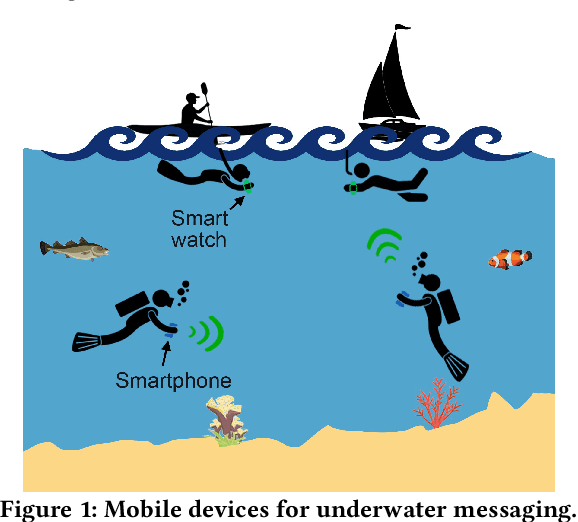
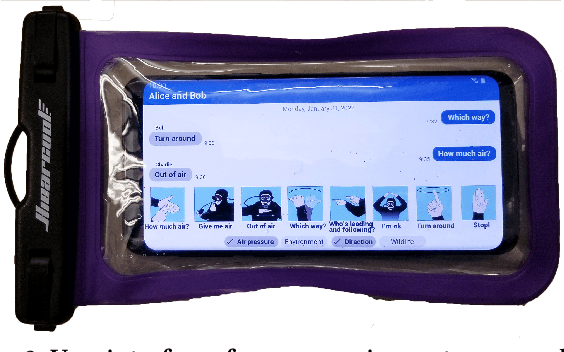

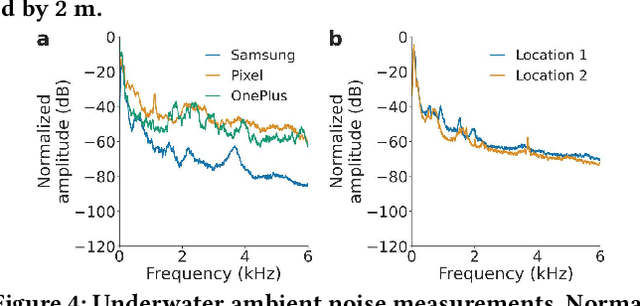
Abstract:Since its inception, underwater digital acoustic communication has required custom hardware that neither has the economies of scale nor is pervasive. We present the first acoustic system that brings underwater messaging capabilities to existing mobile devices like smartphones and smart watches. Our software-only solution leverages audio sensors, i.e., microphones and speakers, ubiquitous in today's devices to enable acoustic underwater communication between mobile devices. To achieve this, we design a communication system that in real-time adapts to differences in frequency responses across mobile devices, changes in multipath and noise levels at different locations and dynamic channel changes due to mobility. We evaluate our system in six different real-world underwater environments with depths of 2-15 m in the presence of boats, ships and people fishing and kayaking. Our results show that our system can in real-time adapt its frequency band and achieve bit rates of 100 bps to 1.8 kbps and a range of 30 m. By using a lower bit rate of 10-20 bps, we can further increase the range to 100 m. As smartphones and watches are increasingly being used in underwater scenarios, our software-based approach has the potential to make underwater messaging capabilities widely available to anyone with a mobile device. Project page with open-source code and data can be found here: https://underwatermessaging.cs.washington.edu/
 Add to Chrome
Add to Chrome Add to Firefox
Add to Firefox Add to Edge
Add to Edge